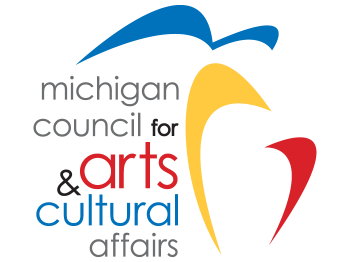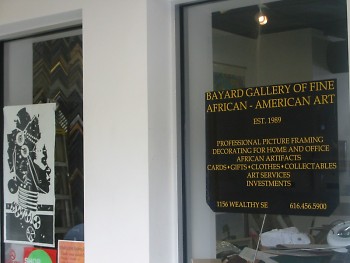In the wake of continuing vandalism in the Wealthy Street business district, I feel compelled to offer another take on the so-called gentrification of the area. As a lifelong resident of Delaware, I moved here in 1988 to open my first art gallery on Michigan Street. While trying to get acquainted with my customers and Grand Rapids, I joined any organization that would help grow my business. I was asked to join a group preparing to restore Wealthy Theatre, my first big project in Grand Rapids. All the while, members beckoned me to move to Wealthy once the renovation was complete, as the building would house business spaces.
The Bayard Gallery of Fine African American Art on Michigan Street was a small, low-overhead, starter location “way on the other side of town,” as my customers said to my bafflement. I lived in Philadelphia before moving to GR, and I worked across town from where I lived. Roosevelt Avenue in the greater northeast quadrant to Patterson Avenue near the airport is 25 miles, not four blocks. I did consider a move to Wealthy, but in the late '80s and '90s, crime, gangs and drugs ruled that area even though there were at least a dozen black-owned businesses already operating on Wealthy. My customers told me at that time that they wouldn’t shop there. Even the McDonald's closed down for safety reasons. So we remained on Michigan.
The theatre and connected buildings were remodeled, opened and occupied. After about 10 years, our building was sold, and we searched for a new spot. Our competition on Wealthy, another black-owned gallery, closed down, and the corner store that was allegedly the source of crime on Wealthy was sold, so we made the decision to move to 1156 Wealthy in 2001.
Philanthropist Peter Wege acquired the building and envisioned a location that promoted education, the arts and finance. We were the first business to move in, then Huntington Bank and later GRCC’s Learning Center. There were plenty of empty storefronts, vacant property and abandoned homes along and around Wealthy. Being the only business on that corner for about a year was a struggle, but our long-standing customers found us. Parking was far better than on Michigan Street and we had windows, unlike most of the open stores on Wealthy that had boards or peepholes.
We are still West Michigan’s experts in African-American art, books, culture and events after 22 years. I am proud to claim a rainbow clientele: African American, Caucasian, African, Hispanic and Asian; Christian, Muslim and Jewish; old and young; liberal and conservative; gay and straight; bank presidents and ex-cons - anyone who wants to know about black art and culture.
This was the Wealthy neighborhood we served since most of my customers traveled from a 10-mile radius. As a businessman and a capitalist, I’d prefer to see the rainbow of customers that frequented my gallery than the crowd that hung out on my corner in the '90s. For the nine years I operated a gallery on Wealthy, I never had an incident of vandalism or damage to the building. I empathize with the merchants there, many of whom I know, for suffering this ongoing, misguided destruction of property.
A quick search for "gentrification" will direct you to Wikipedia:
“In 1964 the British sociologist Ruth Glass coined the term “gentrification” to denote the influx of middle-class people to cities and neighborhoods, displacing lower-class worker residents. Gentrification is a housing, economic, and health issue that affects a community’s history and culture and reduces social connections. It often shifts a neighborhood's characteristics e.g. racial–ethnic composition and household income, by adding new stores and resources in previously run-down neighborhoods."
So is this truly what is happening on Wealthy Street to provoke people into committing crimes to get their point across? I believe that some shifting is happening, but most of the community forums in the last five years have been open for the public to voice opinions. When rehabilitation of a neighborhood or business district starts in a community, displacement will happen. We survived two years of utility and street construction knowing that the new streetscape, lighting, benches and signage would benefit us in the long run. Others closed their doors for good and some opened new business after the road construction. I don’t believe that one class of people is moving out another.
The Wealthy Street area is a rainbow of people, as I stated. There are new homes in the $150,000 range and Section 8 homes in the same neighborhood, banks and thrift shops, bars of all types that cater to the local folks and those who venture in. I don’t see the stark class warfare that typifies gentrification.
The Bayard Gallery closed on Wealthy not because we were forced out with high rents but because of the overall tough economy in 2007-2008. People won't buy art when there are more pressing needs.
So who are the vandals angry with? The merchants who are just trying to make a living? The landlords who are trying to recoup investment dollars? The customers who are just buying coffee, pizza or artwork? I think the vandals are angry with themselves for not buying one of the many vacant buildings and starting their own business or buying a foreclosed home in the area for pennies-on-the-dollar and rehabbing it. That will be difficult now that they will be facing prison time or fines when they get caught. I guess it’s easier to throw bricks and spray paint to protect what is perceived as their neighborhood.
When I first started to renovate the Theatre, we found a stash of photographs picturing Wealthy Street during the last century and one thing is clear: Wealthy Street is always changing and always will. My old building was a drugstore/soda shop, then a corner store/barbershop, now a bank and college. Different ethnic groups have claimed sections over the years while generally living in peace and harmony. It is a shame that those bent on anarchy for the sake of anarchy want to take us backwards. In these tough economic times, the Wealthy Street merchants should be supported and applauded.
George Bayard III
Bayard Art Consulting & Frameshop
The Rapidian, a program of the 501(c)3 nonprofit Community Media Center, relies on the community’s support to help cover the cost of training reporters and publishing content.
We need your help.
If each of our readers and content creators who values this community platform help support its creation and maintenance, The Rapidian can continue to educate and facilitate a conversation around issues for years to come.
Please support The Rapidian and make a contribution today.


Comments
Mr. Bayard,
Thanks for your account of your experiences. It's good to hear things from your perspective. In the discussion following the acts of vandalism, I read many people speaking on your behalf (probably without your knowledge or consent), and saying that your decision to close your gallery was - by your own admission - the result of increased rents, presumably caused by gentrification.
If you read any of the same commentaries, I suspect you weren't too fond of being used as Exhibit A in the "gentrification exists on Wealthy Street and here's the proof" arguments. I saw several instances of people bending their understanding of your situation to their own rhetorical purposes.
Having the definitive word from your own mouth (or keyboard) certainly won't resolve the debate about gentrification on Wealthy Street, but it will at least help to clear up some of the confusion.
What a fantastic op-ed piece and so educational about what it is like to live and work in East Hills. We are so lucky to have such talented leaders in our city. The vandals are fighting for something that never existed for people who don't want or need their pathetic help.
Thank you for taking the time to share your invaluable perspective on your history in the neighborhood. One of our highlights of the past several years was displaying art from your gallery on our walls, in the West Lobby at Wealthy Theatre. Please know you are missed on Wealthy Street and spoken of very fondly, and often.
Best,
Erin Wilson, Director
Wealthy Theatre
Thank you for an eloquent commentary. Come back to Wealthy Street!